Does it make sense to Rent vs Own?

The current break-even horizon* in the Seattle metro area is 1.6 years!
*The amount of time you need to own your home in order for owning to be a superior financial decision.
With rising rental rates, historically low interest rates, and home prices on the rise, the advantage of buying vs. renting is becoming clearer each month.
In fact, Seattle has seen some of the sharpest rent hikes in the country over the last year! Snohomish County has seen a huge increase in apartment growth and rising rental rates as well. There are several factors to consider that will lead you to make the best decision for your lifestyle and your financial bottom line. Zillow Research has determined the break-even point for renting vs. buying in our metro area. In other words, the amount of time you need to own your home in order for owning to be a superior financial decision. Currently in Seattle the break-even point is 1.6 years – that is quick! What is so great about every month that ticks away thereafter is that your nest egg is building in value.
I am happy to help you or someone you know assess your options; please contact me anytime.
These assumptions are based on a home buyer purchasing a home with a 30-year, fixed-rate mortgage and a 20 percent down payment; and a renter earning five percent annually on investments in the stock market.
Veggie Planting

It’s not too late! If you’re thinking about planting some fresh veggies but haven’t started yet, you still have time to get things in the ground for a late summer/early fall harvest. On average, the Puget Sound’s frost-free growing season is mid-March through mid-November, so with a little knowledge of when and how to start things, you can still see a bountiful harvest this year.
Some plants can be direct seeded into your garden, while others should be started indoors before being transplanted to your garden space. Deciding what to grow is the fun part! Plant what you like to eat, keeping in mind that some plants do better in our area than others.
Broccoli is arguably one of the most productive veggies you can grow in this area, although it can be vulnerable to root maggots and aphids. Giant Italian Parsley is easy to grow, highly productive, and expensive in the grocery store. Leeks are another that can be costly to buy in the store but trouble-free to grow in your own small space. Chard, Kale, Lettuce and Arugula are all full of vitamins and great for Northwest gardens. Carrots, Snap Peas, Snap Beans, Tomatoes and Basil all taste amazing fresh from the garden and grow relatively well in this area.
Check out the great resources at Garden.org for a full list of when to plant all these vegetables and more. They have detailed timelines for both spring and fall gardening; as well as information on transplanting seedlings vs. direct-sowing seeds.
Why We Are Not Headed for Another Housing Bubble

Double-digit price appreciation has taken place for over 3 years now, so prices are up. Way up. In fact, in just the last year we have seen prices rise 14% year-over-year. When talking with people about our real estate market, the conversation often involves the question, “are we headed toward a bubble?” We get asked this question often, and it is understandable. With the Great Recession not too far back in our rear-view mirror, the fear that surrounds the bottom dropping out in our home values is real. The large price gains might seem familiar to the gains of the previous up market of 2004-2007, but the environment is much different, and that is why we are not headed toward a housing collapse.
Lending Requirements & Down Payments
Previous lending practices allowed people to get into homes with high debt-to-income ratios, low credit scores, risky loan programs, and undocumented incomes. They called this sub-prime lending. This led to the housing bubble bursting 10 years ago – because people received mortgages they were not equipped to handle. Borrowers were not properly qualified for their monthly payments, and with minimal down payments they had no skin in the game. There were also a ton of adjustable rate mortgages and interest-only loans, which created negative equity positions. In July 2007, the sub-prime loan products disappeared and literally became history overnight. This eliminated a large part of the buyer pool creating over supply, not to mention the foreclosures that followed due to these ill-equipped homeowners walking away. The combination of these two factors caused prices to plummet.
Conversely, in March of this year, the average credit score for an approved conventional loan according to Ellie Mae was 752. Banks are scrutinizing their borrowers much more thoroughly than in the past. Credit scores are only the start; solid documentation of employment, assets, and debt are all passed through strict underwriting standards before closing. During the days of sub-prime lending, banks were funding loans with scores as low as 560! This, coupled with many zero-down loan programs and the risky terms mentioned above, left many new homeowners with little to no equity. When you have little or no equity it is very easy to bail.
In addition to heartier credit scores, down payments have increased significantly. According to Attom Data Solutions the average down payment is 18%. To put this in perspective, the median price in Seattle Metro in the first quarter of 2018 was $775,000. 18% of that is $139,500! There is a marked difference in the connection to one’s investment with such a large amount on the line versus the common 0% down loans of the sub-prime era. When people have high equity levels they are not likely to abandon their home or miss payments.
Our Thriving Local Economy, Job Creation & Californians
According to Matthew Gardner, Windermere’s Chief Economist, it is forecasted that there will be 46,000 more jobs in the Seattle Metro area in 2018. This has created high numbers of residual migration into our area from other states. In 2016 there were 50,000 people that moved here, and 47,000 in 2017. Many of these new Washingtonians are former Californians, specifically from the Bay Area. Unbelievably, our prices are attractive to this group, as they can take a similar tech job here and make the same income with a lower cost of living. If untethered and up for a move, it’s a no-brainer.
The most influential factor that has led the run on prices has been low inventory levels coupled with high housing demand. It’s simply the concept of supply and demand. The growth of companies like Amazon, Google, and Facebook in our area has created increased demand, especially for homes closer to job centers resulting in shorter commutes. When you have increased demand and not enough homes to absorb the buyers, prices go up. Over the last three years we have easily seen a 10%+ increase in prices year-over-year. That is above the norm, and will slow down once inventory increases. That slowdown will be welcomed and it will not be a collapse in values or a bubble bursting.
Interest Rates
Interest rates are increasing, and it is predicted they will reach close to 4.95% by the end of the year. This will naturally curtail price growth because it will not be as cheap to borrow money, which will cause buyers to temper their pricing ceilings. Bear in mind, that an interest rate of 4.95% is still historically low, we’ve just been incredibly fortunate to be able to secure long term loans with minimal debt service. The average interest rate over the last 30 years is 7%.
We understand that the recent increase in home prices has been big and that it might remind you of the previous up market before the crash. Hopefully digging into the topics above has shed some light on how it is different. We always welcome the opportunity to have conversations about these hot topics and discern how they relate to you. As always, it is our goal to help keep our clients informed and empower strong decisions. Please let us know if we can answer any questions or help you or anyone you know with their real estate needs.
Farmers Market 2018
Farmer’s Market Schedule – 2018
South Snohomish County
Arlington Farmers Market Legion Park: 200 N. Olympic Ave Saturdays. 10am-3pm | July 7 — Sept 29
Bothell Farmers Market Country Village: 23718 Both-Evrt Hwy Fridays 12pm-6pm | June 1—Sept 28
Bothell South County Community Market Park Ridge Church: 3805 Maltby Road, Bothell Wednesdays 4pm-8pm | June 6—Sept 26
Edmonds Garden Market Historical Museum: Between 5th & Bell Street Saturdays 9am-2pm | May 5—June 9
Edmonds Summer Market Downtown: 5th St from the fountain Saturdays 9am-3pm | June 16—Oct 6
Everett Farmers Markets Boxcar Park: 615 13th Street Sundays 11am-4pm | May 13—Oct 14
Everett Transit Center: 2333 32nd St Wednesdays 4pm-8pm | May 23—Sept 26
Marysville Farmers Market 1035 State Ave Saturdays 10am-2pm | June 23—Sept 1
Monroe Farmer’s Market Lake Tye Park: 14964 Fryelands Blvd Saturdays 8:30am-12:30pm | May 12—Nov 17
Mukilteo Farmers Market Lighthouse Park: 609 Front Street Wednesdays 3pm-7pm | June 7—Sept 27
Snohomish Farmers Market The intersection of Cedar Ave & Pearl St. Thursdays 3pm-7pm | May 3—Sept 27
The Eastside
Bellevue Farmers Market First Presbyterian: 1717 Bellevue Way NE Thursdays. 3pm-7pm | May 17—Oct 11
Bothell Farmers Market Country Village: 23718 Both-Evrt Hwy Fridays 12pm-6pm | June 1—Sept 28
Issaquah Farmers Market Pickering Barn: 1730 10th Ave NW Saturdays 9am-2pm | May 5—Sept 29
Juanita Friday Market Juanita Beach Park: 9703 NE Juanita Dr Fridays. 3pm-7pm | June 1—Sept 28
Mercer Island Farmers Market Mercerdale Park: 7700 SE 32nd St Sundays 10am-3pm | June 3—Oct 7
Redmond Saturday Market Redmond Town Center: 7730 Leary Way NE Saturdays 9am-3pm | May 5—Oct 27
Sammamish Farmers Market City Hall Plaza: 801 228th Ave SE Wednesdays 4pm-8pm | May 9—Sept 26
Woodinville Farmers Market DeYoung Park: 13680 NE 175th St Saturdays 9am-3pm | May 5—Sept
Seattle Area
Ballard Farmers Market Ballard Ave NW Sundays. 10am-3pm | Year round
Capitol Hill Broadway Farmers Market Seattle Central Comm College: Broadway & Pine Sundays 11am-3pm | Year round
Columbia City Farmers Market 37th Ave S & S Edmunds St Wednesdays 3pm-7pm | May 9—Oct 10
Fremont Sunday Market Corner of 3410 Evanston Ave N Sundays 10am-4pm | Year round
Lake City Farmers Market 125th St and 28th Ave NE Thursdays 3pm-7pm | June 7—Oct 4
Lake Forest Park Farmers Market Third Place Commons: 17171 Bothell Way NE Sundays 10am-3pm | May 13—Oct 21
Madrona Farmers Market 1126 Martin Luther King Jr. Way Fridays 3pm-7pm | May 18—Oct 12
Magnolia Farmers Market Magnolia Village: 33rd Ave W & W McGraw Saturdays. 10am-2pm | June 2—Oct 20
Phinney Farmers Market Phinney Neighborhood Center: Phinney Ave N Fridays 3:30pm-7:30pm | June 1—Sept 28
Pike Place Farmers Market Pike Place & Pine St Saturdays 9am-5pm | June 2—Nov 24
Queen Anne Farmers Market W Crockett Street & Queen Anne Ave N Thursdays 3pm-7:30pm | June 7—Oct 11
Shoreline Farmers Market 15300 Westminster Ave N Saturdays 10am-3pm | June 9—Oct 6
University District Farmers Market University Way NE “the Ave” Saturdays 9am-2pm | Year round
Wallingford Farmers Market Meridian Park: Meridian Ave N & N 50th St Wednesdays 3pm-7pm | May 16—Sept 26
West Seattle Farmers Market California Ave SW & SW Alaska St Sundays 10am-2pm | Year round
Quarterly Reports: Q1 North Snohomish
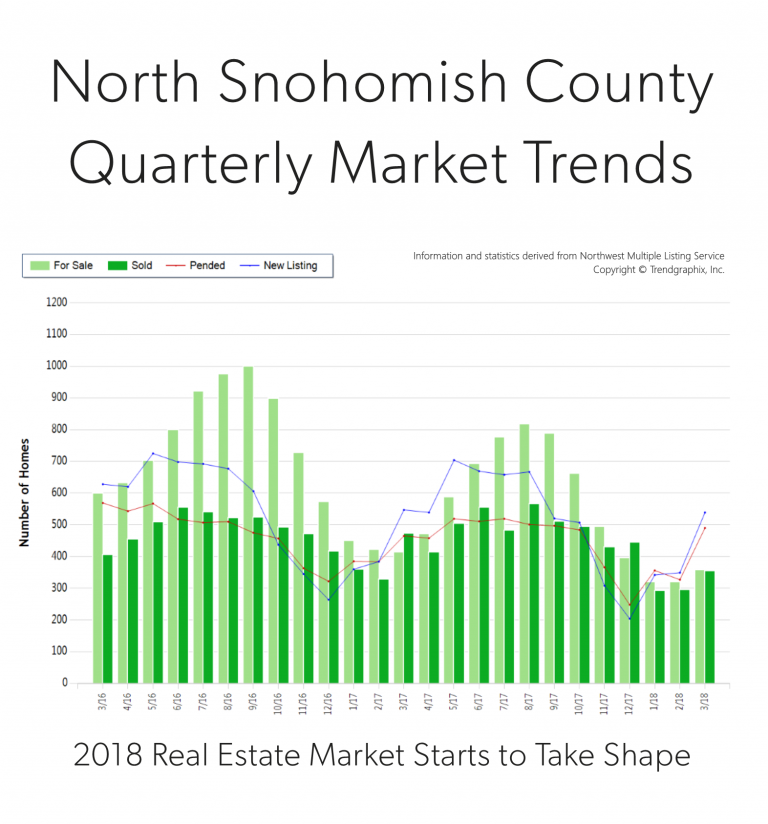
Q1: January 1 – March 31, 2018
It is the time of year when our market starts to take off. Spring is here and we are starting to see seasonal increases in inventory.
 In fact, there was a 54% increase in new listings in March compared to February. That increase was matched by a 50% rise in pending sales, illustrating very strong demand for housing in your area. Last month, the average list-to-sale price ratio was 100%, and average days on market was 35 days. We ended the quarter with 0.7 months of inventory – the lowest level yet. More inventory would be absorbed by happy buyers looking for more selection and would help temper price growth, which is up 12% year-over-year.
In fact, there was a 54% increase in new listings in March compared to February. That increase was matched by a 50% rise in pending sales, illustrating very strong demand for housing in your area. Last month, the average list-to-sale price ratio was 100%, and average days on market was 35 days. We ended the quarter with 0.7 months of inventory – the lowest level yet. More inventory would be absorbed by happy buyers looking for more selection and would help temper price growth, which is up 12% year-over-year.
North Snohomish County is one of the most affordable markets in the area. In fact, the median price in March was 28% higher in south Snohomish County. Buyers are migrating to the area, especially if they don’t have to commute into the city. Sellers are enjoying amazing returns due to this phenomenon, and buyers are securing mortgages with minor debt service due to low interest rates. This is a very strong seller’s market, but buyers who are securing a home are already enjoying appreciation in equity.
This is only a snapshot of the trends in north Snohomish County; please contact us if you would like further explanation of how the latest trends relate to you.
Quarterly Market Trends: Q1 South Snohomish
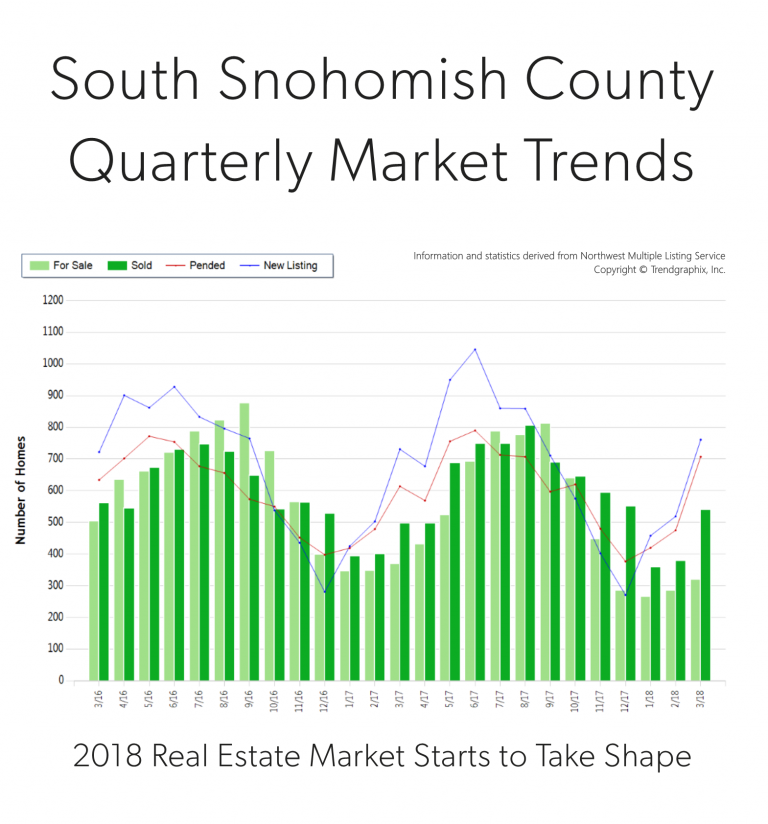
Q1: January 1 – March 31, 2018
It is the time of year when our market starts to take off. Spring is here and we are starting to see seasonal increases in inventory.
 In fact, there was a 47% increase in new listings in March compared to February. That increase was matched by a 48% rise in pending sales, illustrating very strong demand for housing in your area. Last month, the average list-to-sale price ratio (how the sale price relates to the list price) was 103%, indicating that multiple offers were the norm. We ended the quarter with 0.5 months of inventory – the lowest level yet. More inventory would be absorbed by happy buyers looking for more selection and would help temper price growth, which is up 15% year-over-year.
In fact, there was a 47% increase in new listings in March compared to February. That increase was matched by a 48% rise in pending sales, illustrating very strong demand for housing in your area. Last month, the average list-to-sale price ratio (how the sale price relates to the list price) was 103%, indicating that multiple offers were the norm. We ended the quarter with 0.5 months of inventory – the lowest level yet. More inventory would be absorbed by happy buyers looking for more selection and would help temper price growth, which is up 15% year-over-year.
South Snohomish County real estate has been a hot spot due to reasonable commute times and overall affordability compared to “in-city” real estate. In fact, the median price in March was 47% higher in Seattle Metro. Sellers are enjoying amazing returns due to this phenomenon, and buyers are securing mortgages with minor debt service due to low interest rates. This is a very strong seller’s market, but buyers who are securing a home are already enjoying appreciation in equity.
This is only a snapshot of the trends in south Snohomish County; please contact us if you would like further explanation of how the latest trends relate to you.
Quarterly Market Trends: Q1 North King County
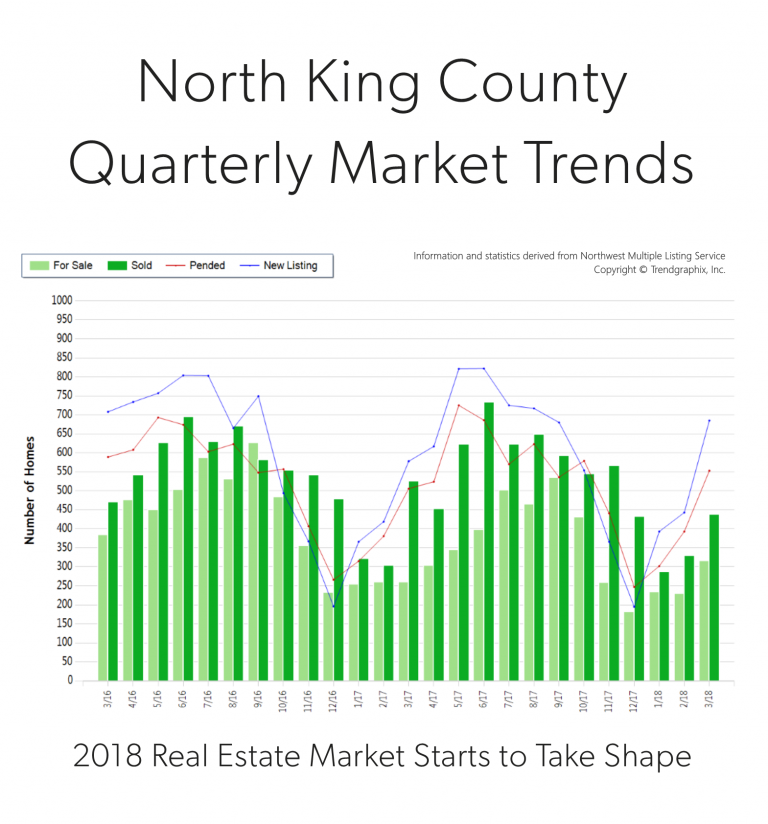
Q1: January 1 – March 31, 2018
It is the time of year when our market starts to take off. Spring is here and we are starting to see seasonal increases in inventory.
 In fact, there was a 55% increase in new listings in March compared to February. That increase was followed by a 41% rise in pending sales, illustrating very strong demand for housing in your area. Last month, the average list-to-sale price ratio (how the sale price relates to the list price) was 106%, indicating that multiple offers were the norm. We ended the quarter with 0.6 months of inventory based on pending sales. More inventory would be absorbed by happy buyers looking for more selection and would help temper price growth, which is up 14% year-over-year.
In fact, there was a 55% increase in new listings in March compared to February. That increase was followed by a 41% rise in pending sales, illustrating very strong demand for housing in your area. Last month, the average list-to-sale price ratio (how the sale price relates to the list price) was 106%, indicating that multiple offers were the norm. We ended the quarter with 0.6 months of inventory based on pending sales. More inventory would be absorbed by happy buyers looking for more selection and would help temper price growth, which is up 14% year-over-year.
North King County real estate has a very high premium due to close-in commute times and desirable neighborhoods. In fact, the median price in March was $808,000, up 4% from the month prior! Sellers are enjoying amazing returns due to this phenomenon, and buyers are securing mortgages with minor debt service due to low interest rates. This is a very strong seller’s market, but buyers who are securing a home are already enjoying appreciation in equity.
This is only a snapshot of the trends in north King County; please contact us if you would like further explanation of how the latest trends relate to you.
Quarterly Market Trends: Q1 Eastside
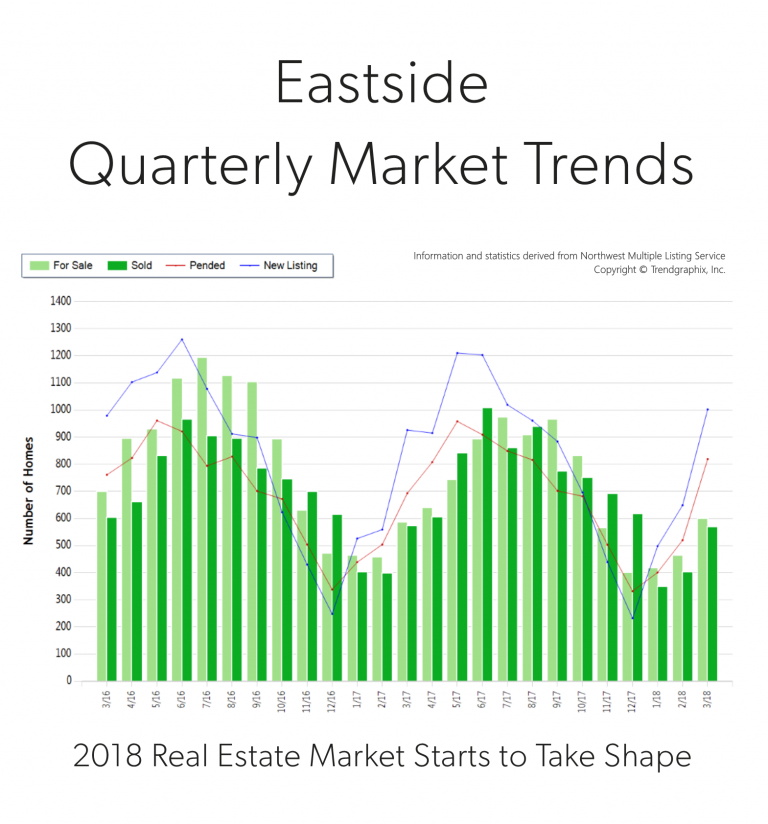
Q1: January 1 – March 31, 2018
It is the time of year when our market starts to take off. Spring is here and we are starting to see seasonal increases in inventory.
 In fact, there was a 54% increase in new listings in March compared to February. That increase was topped by a 58% rise in pending sales, illustrating very strong demand for housing on the Eastside. Last month, the average list-to-sale price ratio (how the sale price relates to the list price) was 103%, indicating that multiple offers were the norm. We ended the quarter with 0.7 months of inventory – the lowest level yet. More inventory would be absorbed by happy buyers looking for more selection and would help temper price growth, which is up 14% year-over-year.
In fact, there was a 54% increase in new listings in March compared to February. That increase was topped by a 58% rise in pending sales, illustrating very strong demand for housing on the Eastside. Last month, the average list-to-sale price ratio (how the sale price relates to the list price) was 103%, indicating that multiple offers were the norm. We ended the quarter with 0.7 months of inventory – the lowest level yet. More inventory would be absorbed by happy buyers looking for more selection and would help temper price growth, which is up 14% year-over-year.
Eastside real estate has a very high premium due to close-in commute times and desirable neighborhoods. In fact, the median price in March was $927,000! Sellers are enjoying amazing returns due to this phenomenon, and buyers are securing mortgages with minor debt service due to low interest rates. This is a very strong seller’s market, but buyers who are securing a home are already enjoying appreciation in equity.
This is only a snapshot of the trends on the Eastside area; please contact us if you would like further explanation of how the latest trends relate to you.
Quarterly Market Trends: Q1 Seattle Metro
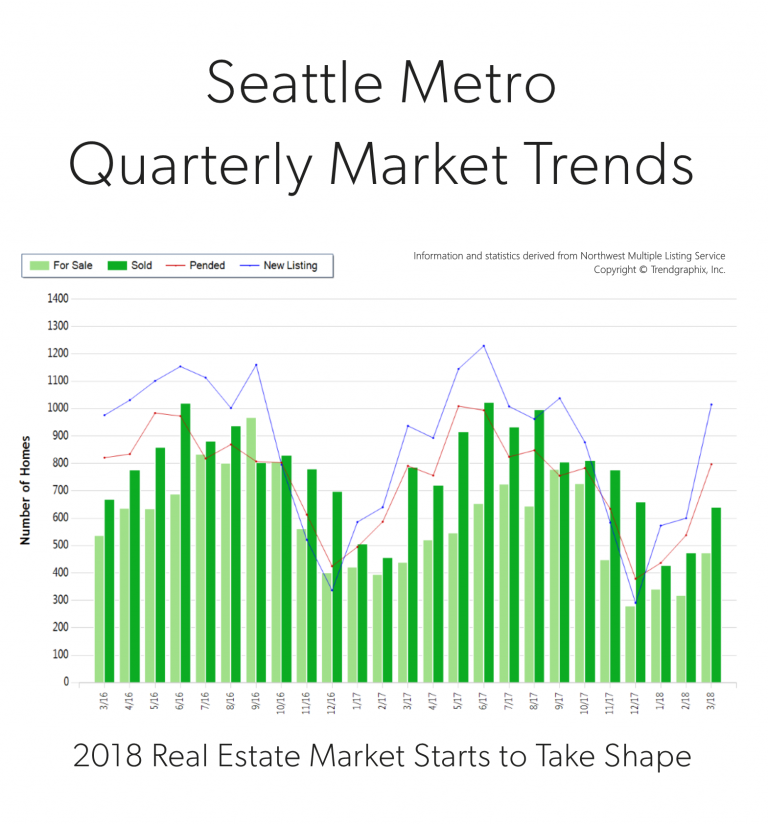
Q1: January 1 – March 31, 2018
It is the time of year when our market starts to take off. Spring is here and we are starting to see seasonal increases in inventory.
 In fact, there was a 69% increase in new listings in March compared to February. That increase was followed by a 48% rise in pending sales, illustrating very strong demand for housing in your area. Last month, the average list-to-sale price ratio (how the sale price relates to the list price) was 105%, indicating that multiple offers were the norm. We ended the quarter with 0.6 months of inventory based on pending sales. More inventory would be absorbed by happy buyers looking for more selection and would help temper price growth, which is up 16% year-over-year.
In fact, there was a 69% increase in new listings in March compared to February. That increase was followed by a 48% rise in pending sales, illustrating very strong demand for housing in your area. Last month, the average list-to-sale price ratio (how the sale price relates to the list price) was 105%, indicating that multiple offers were the norm. We ended the quarter with 0.6 months of inventory based on pending sales. More inventory would be absorbed by happy buyers looking for more selection and would help temper price growth, which is up 16% year-over-year.
Seattle Metro real estate has a very high premium due to close-in commute times and vibrant neighborhoods. In fact, the median price in March was $800,000, up 5% from the month prior! Sellers are enjoying amazing returns due to this phenomenon, and buyers are securing mortgages with minor debt service due to low interest rates. This is a very strong seller’s market, but buyers who are securing a home are already enjoying appreciation in equity.
This is only a snapshot of the trends in the Seattle Metro area; please contact us if you would like further explanation of how the latest trends relate to you.
Quarterly Market Trends: Q1 South King County
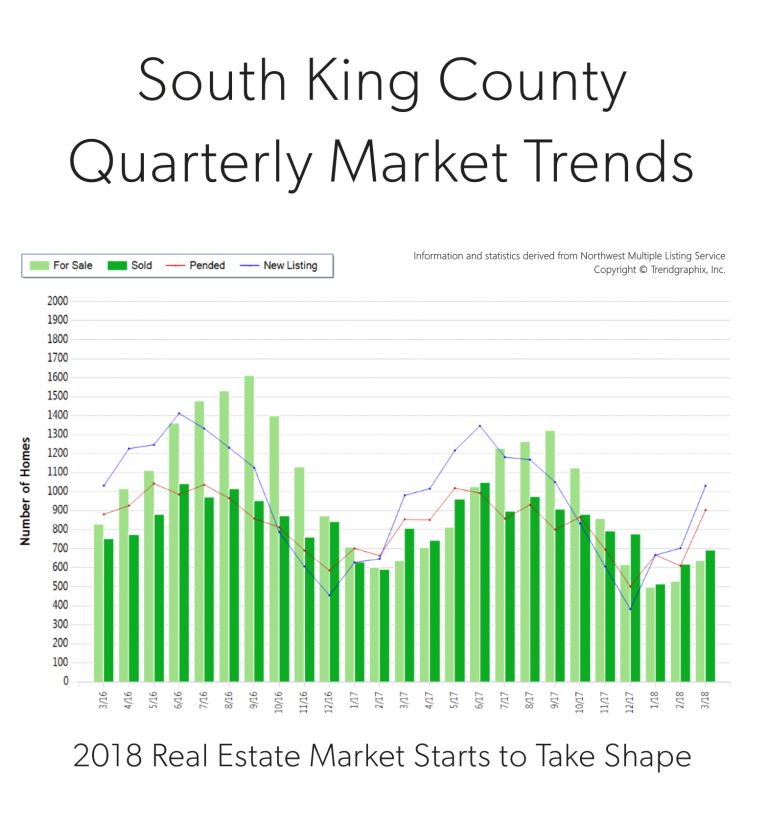
Q1: January 1 – March 31, 2018
It is the time of year when our market starts to take off. Spring is here and we are starting to see seasonal increases in inventory.
 In fact, there was a 47% increase in new listings in March compared to February. That increase was matched by a 48% rise in pending sales, illustrating very strong demand for housing in south King County. Last month, the average list-to-sale price ratio (how the sale price relates to the list price) was 101%, indicating that multiple offers were the norm. We ended the quarter with 0.7 months of inventory – the lowest level yet. More inventory would be absorbed by happy buyers looking for more selection and would help to temper price growth, which is up 12% year-over-year.
In fact, there was a 47% increase in new listings in March compared to February. That increase was matched by a 48% rise in pending sales, illustrating very strong demand for housing in south King County. Last month, the average list-to-sale price ratio (how the sale price relates to the list price) was 101%, indicating that multiple offers were the norm. We ended the quarter with 0.7 months of inventory – the lowest level yet. More inventory would be absorbed by happy buyers looking for more selection and would help to temper price growth, which is up 12% year-over-year.
South King County real estate has been a hot spot due to reasonable commute times and overall affordability compared to “in-city” real estate. In fact, the median price in March was 78% higher in Seattle Metro. Sellers are enjoying amazing returns due to this phenomenon, and buyers are securing mortgages with minor debt service due to low interest rates. This is a very strong seller’s market, but buyers who are securing a home are already enjoying appreciation in equity.
This is only a snapshot of the trends in south King County; please contact us if you would like further explanation of how the latest trends relate to you.
 Facebook
Facebook
 X
X
 Pinterest
Pinterest
 Copy Link
Copy Link

